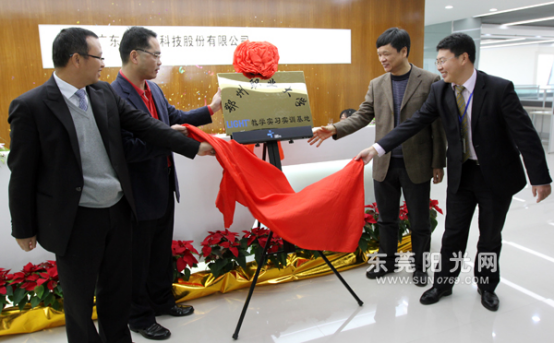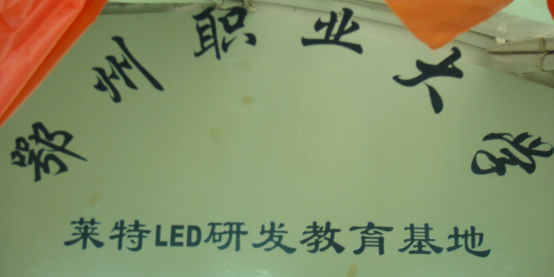University-Enterprise 'Marriage' – A Win-Win Collaboration !
At 10:00 AM on October 18, 2012, the founding ceremony of the "School-Industry-Enterprise" Cooperative Education Work Committee of the Electronics Department of Ezhou Polytechnic and the unveiling ceremony of the "LIGHT LED R&D Education Base" were successfully held in the conference room on the first floor of the university library. The unveiling of the education base marked the beginning of the "school-enterprise cooperation" between Shenzhen LIGHT Optoelectronics Co., Ltd. (hereinafter referred to as "LIGHT") and Ezhou Polytechnic (hereinafter referred to as "EZPC")

Policy-Driven Scientific Development
Wang Jianli, Director of Ezhou Polytechnic, stated: "The 'LIGHT LED R&D Education Base' represents a key initiative under our innovative school-enterprise cooperation mechanism. This mechanism forms an integral part of our national backbone vocational college construction, implemented in accordance with the Ministry of Education's Guidelines on Promoting Coordinated Development of Secondary and Higher Vocational Education (No. 9 [2011]) and Several Opinions on Advancing Higher Vocational Education Innovation to Lead Scientific Development of Vocational Education (No. 12 [2011])."
Amid the government's full push for vocational education reform, critical questions emerge:
How to innovate vocational education systems?
How to achieve coordinated development between secondary and higher vocational education?
How to build a modern vocational education framework?
These challenges require collective solutions from government, institutions, industries, and enterprises. In this context, innovative school-enterprise cooperation models have emerged as a "dark horse," achieving threefold outcomes:
Policy Alignment: Government guidance ensures strategic direction
Market Relevance: Schools maintain societal demand responsiveness
Talent Pipeline: Enterprises gain industry-ready professionals
By synergizing policy implementation with practical needs, this model exemplifies how to pursue mutually beneficial development through institutional collaboration.

Institutions: Cultivating High-End Talent with Future Vision
As a rapidly emerging industry, LED technology has gained significant attention from universities across China. Institutions like Tianjin Polytechnic University and Guangdong Textile Vocational Technical College have established LED-related programs. Notably, universities in key LED development regions are adopting school-enterprise collaboration models to design curricula that cultivate urgently needed skilled professionals.
Ezhou Polytechnic's partnership with Lite Optoelectronics to establish the "LIGHT LED R&D Education Base" represents an innovative approach that: Aligns with cutting-edge developments in photonics, particularly LED technology,Deepens institutional-industry collaboration,Creates an intellectual platform for program development and reform,Achieves four key synergies:Cooperative program development,Joint talent cultivation,Enhanced graduate employment,Mutual development growth.
"The education base provides dual benefits," explained Li Lu, Director of the Establishment Office at Ezhou Polytechnic, speaking enthusiastically to Gaogong LED reporters. "Academically, we offer intellectual support to enterprises, while companies transition from traditional factory R&D models. Our collaborative research projects integrate R&D with professional education. The experimental production line on campus serves both research and teaching purposes, giving students hands-on experience with industry-standard LED technologies – ensuring they graduate job-ready with relevant, cutting-edge skills."
Reforming Vocational Education
Addressing how to advance vocational education innovation, Li Lu emphasized the necessity for transformation:Secondary vocational schools should focus on cultivating frontline operators,Higher vocational institutions must aim higher – developing advanced technical professionals.
"The key lies in innovating school-enterprise collaboration models," Li Lu stated. "By partnering with industry leaders like Lite, we elevate learning platforms to expose students to: Contemporary industry advancements,
Enterprise-level technologies,Higher-order competencies in production management,Technological innovation, R&D participation.
This ensures our graduates' knowledge remains applicable, valuable, and career-sustaining."Looking ahead, Li Lu expressed confidence: "Our collaboration with Lite will accumulate valuable LED industry expertise, paving the way for partnerships with more top-tier R&D enterprises. Ultimately, we aim to cultivate increasing numbers of high-end technical specialists for this vital industry."
Entering the Education Chain to Cultivate Talent
General Manager Feng Haitao of LIGHT discussed with Gaogong LED reporters the current "talent famine" in the LED industry. Due to the late start of China's domestic LED industry, there has always been a shortage of specialized talent cultivation.
Feng Haitao expressed deep concern about the talent gap in the LED industry: "In the development of a company, many processes rely on its workforce, as leaders cannot handle everything personally. A company’s talent structure and mechanisms determine whether it is well-established and whether its execution is effective. Therefore, talent is crucial for enterprises."
Currently, recruitment difficulties, particularly the lack of technical talent, are major challenges. The scarcity of skilled professionals is a critical factor hindering innovation in many companies. Many firms remain in the imitation stage due to the shortage of R&D talent, resulting in a lack of independent creativity.
Some enterprises have begun emphasizing the cultivation of R&D personnel, focusing on training technical talent internally. However, this approach has sometimes backfired, as key trainees may become overly complacent and fail to meet expectations.
To address this, companies are moving laboratories into campuses, allowing students to engage with the LED industry from the outset of their education. By the time these students graduate, they will have already gone through a process of understanding, familiarizing with, and researching the LED field. This ensures a seamless transition from campus to corporate environments. Such an approach is essential for nurturing a new generation of professionals who can lead future technological innovations in the lighting industry.
Shi Guangdian, Deputy General Manager of Lite’s Planning Department, stated that establishing educational bases in schools not only benefits Lite but also contributes to the broader development of the LED industry. "This initiative is our way of giving back to the industry, preparing talent for the development of lighting products that can transform human life, and demonstrating the value of the LED sector," he said.
"As an LED manufacturer, Lite has always aimed to cultivate more technical talent for both the industry and itself. We particularly hope to establish a comprehensive training mechanism in higher education, starting from the fundamentals to refine talent development," Shi Guangdian told reporters.
So, how can "school-enterprise cooperation" in building educational bases become a model for the future development of the LED industry? Gaogong LED examined Lite’s successful collaboration with Ezhou University, exploring how vocational institutions and LED enterprises can form a "talent alliance."
The establishment of LIGHT LED R&D education base and its partnership with Ezhou Vocational University mark a significant step in LIGHT talent-driven corporate strategy. This collaboration represents a new level in integrating corporate training systems with academic practice.
Shenzhen LIGHT Optoelectronics Co., Ltd. provides the necessary equipment, materials, and foundational training programs for LED R&D, while also offering job opportunities for the high-quality graduates from Ezhou University. In return, the university supplies the teaching facilities and cultivates specialized LED optoelectronic professionals for the enterprise.
This "marriage" between academia and industry creates a win-win scenario. It allows schools to enhance their educational standards, students to improve their practical skills and employability, and enterprises to strengthen their corporate culture while selecting top technical talent—achieving mutual success.




